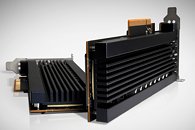Raevenlord
News Editor
- Joined
- Aug 12, 2016
- Messages
- 3,755 (1.21/day)
- Location
- Portugal
| System Name | The Ryzening |
|---|---|
| Processor | AMD Ryzen 9 5900X |
| Motherboard | MSI X570 MAG TOMAHAWK |
| Cooling | Lian Li Galahad 360mm AIO |
| Memory | 32 GB G.Skill Trident Z F4-3733 (4x 8 GB) |
| Video Card(s) | Gigabyte RTX 3070 Ti |
| Storage | Boot: Transcend MTE220S 2TB, Kintson A2000 1TB, Seagate Firewolf Pro 14 TB |
| Display(s) | Acer Nitro VG270UP (1440p 144 Hz IPS) |
| Case | Lian Li O11DX Dynamic White |
| Audio Device(s) | iFi Audio Zen DAC |
| Power Supply | Seasonic Focus+ 750 W |
| Mouse | Cooler Master Masterkeys Lite L |
| Keyboard | Cooler Master Masterkeys Lite L |
| Software | Windows 10 x64 |
NAND has come here to stay, and it's market penetration still has a lot of leeway. Samsung, bar none the biggest and best player in the NAND field, is in a uniquely privileged position to develop new technologies and capitalize on them. Remember that Samsung has so many distinct product lines on which to monetize its advancements that any new investment is hardly a make it or break it affair.
Z-NAND is Samsung's answer to other developing technologies such as 3D XPoint, of which Intel has just announced the first commercial product. Z-NAND looks to stand at the intersection between NAND and DRAM, and is more of an evolution of the NAND design than it is a totally new technology (thus distancing itself from the likes of 3D XPoint.)



Not all of the secret sauce is found on the Z-NAND dies: some of it is in a new controller of which there still are no specifications, which also allows for latency (presumably read latency) that will be 70% lower than current NVMe drives. The pictured Z-SSD, which has already begun sampling to customers, carries 800 GB capacity, and makes use of the PCIe 4x lanes to transmit data. Samsung lists tremendous sequential read and write speeds at up to 3200 Gbps, though its random speeds come in at a much more mundane 750K read and 160K write IOPS. No pricing or availability details are known, though it is expected that these drives will eventually come in at 1 TB, 2 TB, and 4 TB capacities.
View at TechPowerUp Main Site
Z-NAND is Samsung's answer to other developing technologies such as 3D XPoint, of which Intel has just announced the first commercial product. Z-NAND looks to stand at the intersection between NAND and DRAM, and is more of an evolution of the NAND design than it is a totally new technology (thus distancing itself from the likes of 3D XPoint.)



Not all of the secret sauce is found on the Z-NAND dies: some of it is in a new controller of which there still are no specifications, which also allows for latency (presumably read latency) that will be 70% lower than current NVMe drives. The pictured Z-SSD, which has already begun sampling to customers, carries 800 GB capacity, and makes use of the PCIe 4x lanes to transmit data. Samsung lists tremendous sequential read and write speeds at up to 3200 Gbps, though its random speeds come in at a much more mundane 750K read and 160K write IOPS. No pricing or availability details are known, though it is expected that these drives will eventually come in at 1 TB, 2 TB, and 4 TB capacities.
View at TechPowerUp Main Site







